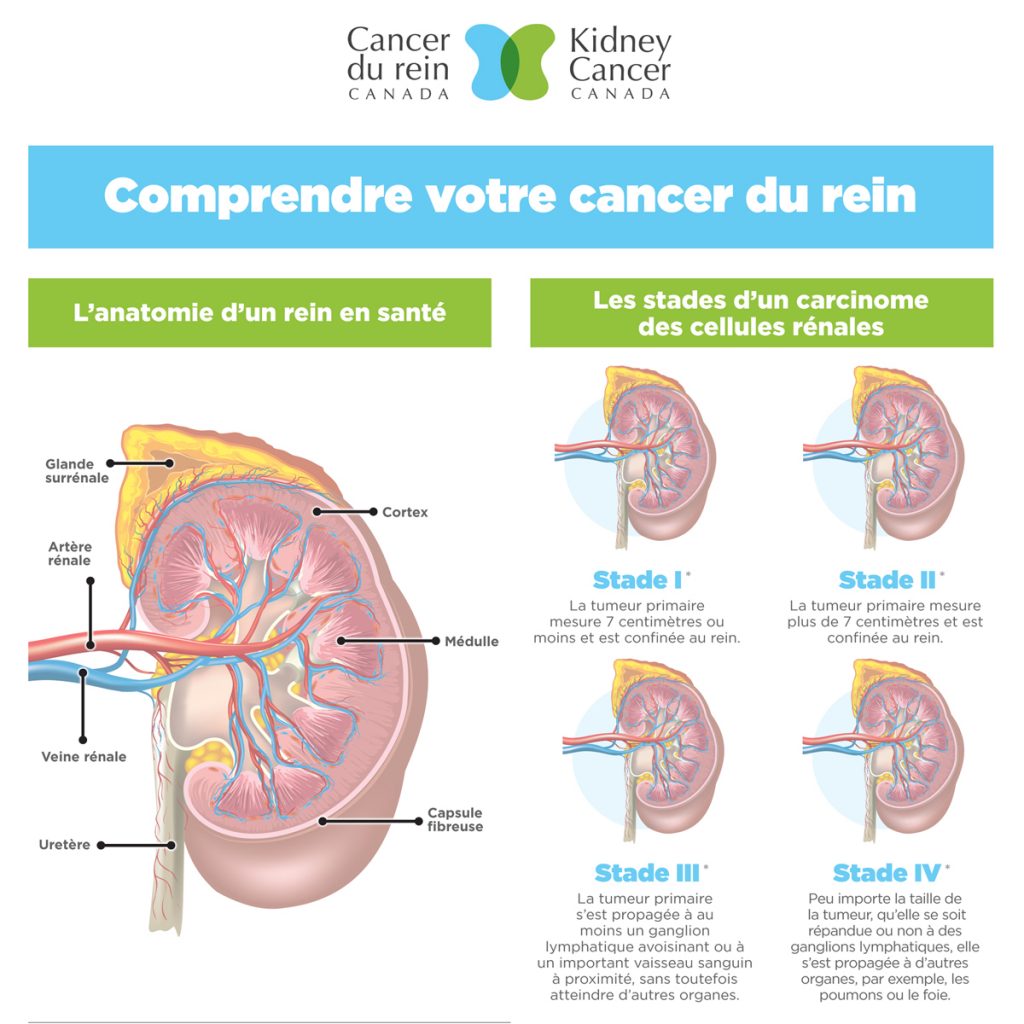Studies show kidney cancer patients and their caregivers involved in their care and treatment decisions lead to a better quality of life.
If you are diagnosed with kidney cancer, a treatment plan will be designed for you by your healthcare team. It is important that you and your physician make informed decisions together after considering the possible treatment options, including potential side effects of medical treatments. A positive approach to treatment can help you cope with the physical demands of surgery and/or medical treatment and can support your recovery.
A treatment plan for kidney cancer may include one or more of the following:
.
ACTIVE SURVEILLANCE
Sometimes your doctor may suggest an approach called active surveillance. This means watching your kidney tumour closely by doing imaging tests such as CT scans, MRIs or ultrasounds and waiting to start treatment until the tumour grows or starts to cause problems. This may be an option for some people with small, slow-growing renal masses (tumour is smaller than 4 cm), or if you are elderly and have other serious health problems. Some patients may not be healthy enough for surgery, or their kidney tumour may not pose a large risk to their health at the time, so treatment and the risks associated with it are delayed until it is really needed. Kidney tumours smaller than 4 cm rarely spread (metastasize). They can usually be removed by doing a partial nephrectomy or treated with ablative therapies, if they start to show aggressive features during surveillance.
The doctor may do a kidney, or renal biopsy, to find out if your kidney mass is cancer or not, what type of tumour it is, how fast it may grow and is likely to spread (tumour histology). This can help them determine if active surveillance is an appropriate option for you.
You may also wish to become part of an active surveillance clinical trial for kidney cancer, if one is available and you are a suitable and willing participant.
TUMOUR ABLATION
There are two tumour ablation techniques radiofrequency ablation (RFA) or cryoablation. These treatments destroy tumour cells without having to remove the tumour from the body. They are less invasive than surgery. Unfortunately, their applicability is limited and their efficacy is much less proven than that of surgery.
- RADIOFREQUENCY ABLATION (RFA) uses a laparoscopic technique to insert a small device into the tumour-bearing kidney. Radiofrequency ablation uses extreme heat on the tumour and surrounding tissue.
- CRYOABLATION uses extreme cold. Both procedures can be done by inserting the heating or cooling device through the skin, or may require a laparoscopic surgery with the insertion of the device.
Both treatment types can be used to treat kidney cancer that has spread to locations beyond the kidney. For example, radiofrequency ablation can be used to treat liver metastases. Neither of these therapies can be used to treat larger tumours and neither has the same efficacy as surgical resection. Both are reserved for the treatment of relatively small tumours.
STEREOTACTIC BODY RADIATION THERAPY (SBRT)
SBRT is the process where high doses of focused radiation are delivered to the tumour while minimizing damage to healthy tissues. SBRT can be used as a treatment on it’s own or in addition to surgery or systemic therapy.
The joint decision between you and your doctors to perform SBRT considers several factors and always includes an analysis of the benefits versus the risks to you. These factors include:
- The size and location of the tumour
- Your age.
- The presence of tumours in both your kidneys
- Whether you have only one functioning kidney
- Whether you have other diseases that may affect your kidney function, now or in the future
- Whether you have other diseases that may affect your ability to tolerate SBRT.
SBRT is usually reserved for patients who are not ideal candidates for surgery due to other medical conditions or patients with advanced age because these small tumours grow very slowly. To find out if SBRT is a good option for your treatment plan, use the following questions to have a discussion with your urologist and your radiation oncologist.
kidney cancer video knowledge library - SBRT
Surgery for the removal of the entire or part of the kidney (nephrectomy) can be done as an open or laparoscopic (keyhole) surgery, with or without robotic assistance. This will depend on:
- The size and position of the small renal mass in the kidney
- The facilities available at the hospital
- The surgeon’s preference and experience
- Your choice
As with any type of surgery, there are certain risks and side effects, such as post-operative discomfort, fatigue, and weakness. Be sure to discuss the potential risks and side effects specific to your situation with your doctor prior to surgery.
OPEN SURGERY
The surgeon usually makes a large incision or cut below the lower ribs on the side of the affected kidney. In cases where a cut below the lower ribs is not possible, the surgeon will suggest an alternative incision to access the kidney. The kidney (or part of the kidney) containing the small renal mass can be assessed by the surgeon and removed through this incision.
LAPAROSCOPIC SURGERY (keyhole or minimally invasive)
The surgeon makes several small incisions or cuts in theskin of the abdomen, rather than one large incision. A long thin tube with a camera and a light at the end is inserted through one of the cuts. This instrument is called a laparoscope. It sends a high-quality image of the operating area to a video monitor. Other small instruments are inserted through the other cuts and used to remove the kidney or part of the kidney containing the small renal mass, which is usually taken out of the body in a bag through one of the cuts.
ROBOT-ASSISTED LAPAROSCOPIC SURGERY (RAS)
RAS is also minimally invasive, but the instruments are smaller and attached to robotic arms. The surgeon controls the robotic arms from a console, which provides a highly magnified 3D view of the operating area. The improved view and advanced tools give the surgeon more precision and control. As it becomes more accessible, RAS will eventually replace conventional laparoscopy for partial nephrectomy.
KIDNEY CANCER VIDEO KNOWLDEGE LIBRARY - ROBOTIC SURGERY
RADICAL NEPHRECTOMY
In a radical nephrectomy, the surgeon removes the entire kidney usually along with the surrounding fatty tissue, the adrenal gland, and nearby lymph nodes.
PARTIAL NEPHRECTOMY
The advantage of partial nephrectomy over radical nephrectomy (entire tumour-bearing kidney removed) is the preservation of renal function. It is very important to preserve as much renal function as possible. The preservation of a part of the tumour-bearing kidney may prevent complications related to renal insufficiency. The most serious of these complications is dialysis. Unfortunately, a partial nephrectomy cannot always be considered. Removal of the entire kidney is often necessary when the tumours are large.
LYMPHADENECTOMY
This surgery removes lymph nodes that have been affected by cancer and is usually done at the time of nephrectomy.
SEE KIDNEY CANCER SURGERY - WHAT TO EXPECT AT HOME
For advanced kidney cancer, systemic therapy options are used before or in addition to surgery. Systemic therapy options may include targeted therapy, immunotherapy, or a combination of these.
Some therapies can be taken by mouth at home. Other types of therapy are given intravenously, requiring you to go to your doctor’s office or clinic to receive them. Unfortunately, there is no therapy that permanently cures kidney cancer. However, there are several therapies that can provide long-term remissions (periods where kidney cancer is dormant).
TARGETED THERAPY
Targeted therapies act on the molecular pathways (a series of actions among molecules in a cell that lead to a certain cell function) involved in the development and spread of kidney cancer. These drugs work by shrinking and slowing the growth of cancer cells and slowing the growth of blood vessels to the tumour.
Current research is focusing on continually refining the action of these targeted therapies. The type of targeted therapy prescribed will depend on the type of kidney cancer, the stage, and any previous targeted therapies used.
SIDE EFFECTS OF TARGETED THERAPIESIMMUNO-ONCOLOGY
Your immune system can recognize abnormal cells and destroy them. This is the basic science behind how immuno-oncology therapy works. Immuno-oncology (IO) therapy is a new (and old) way to treat cancer by activating your immune system in the hope that it will recognize and attack your kidney cancer.
One of the earliest treatments for cancer was a kind of immune therapy. A number of other immune-type therapies have been developed, such as interferon and interleukin-2, but side effects, cost and variable benefits have limited their usefulness.
More recently, newer types of immuno-oncology or IO therapies have been proving successful in some types of cancer. For example, results from early trials of immuno-oncology for advanced skin cancer (melanoma), lung cancer and kidney cancer have been encouraging and some of these drugs have already been approved for use in Canada.
SECTION REFERENCE:
- Surgery (Urology)
- My Treatment, My Choice: A decision aid for people with small renal masses. International Kidney Cancer Coalition (IKCC). Version 1.0 April 2020




























































